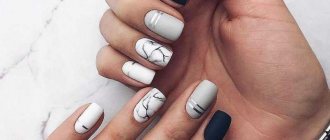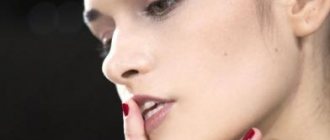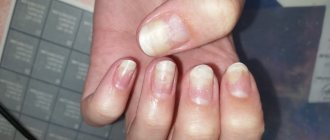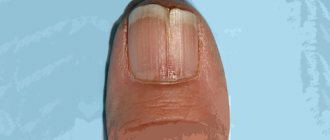The condition of the hands always attracts attention. But you can often find uneven fingernails; the reason for this phenomenon is the presence of a disease, a lack of vitamins, an unsuccessful visit to a nail salon, or a congenital pathology. Therefore, it is worth knowing the different types of deformities of the toenails, hands, causes and treatment.
Types of nail deformities and causes
Due to the negative impact of external and internal factors, deformation or changes in nails occur. Nail deformation is a pathology in which a change in their appearance, structure and shape occurs. The nail plate is normally smooth with a matte-shiny surface, the shape is convex with smooth edges.
Crooked nails imply excessive concavity (convexity), grooves, spots, ribbed surface and increased fragility, the presence of horizontal and vertical waves on the nails. Which is more likely not a defect, but a disease.
Deformation of fingernails, causes:
- infection of fungal etiology;
- skin diseases;
- injury or improper care of the cuticle;
- lack of iron, calcium, vitamins A, B1, C, D, H;
- lack of water and increased waste content;
- internal diseases (gastrointestinal tract, heart, kidneys, joints);
- exposure to chemicals;
- taking antibiotics and undergoing chemotherapy;
- pinching, bruise of the nail bed.
Factors of deformation of the nail plate are acquired, and congenital - a defect of the ectoderm. The pathology consists of a failure at the stage of formation of the nail bed and plate during the intrauterine development of the fetus.
Uneven nails on the thumbs are easier to notice, because they are larger and the pathology is noticeable much faster. Therefore, if you find any defect on your fingernails or toenails, you should immediately contact a medical facility.
Injuries
Everyone has experienced a fingernail or toenail injury at some point. Expressed in a slight abrasion, pinching, falling of a heavy (sharp) object, improper cutting, wearing tight shoes.

Nail bruise is the cause of deformation of the nail plate
Symptoms of a nail injury:
- Soreness and swelling.
- Hemorrhage, cyanosis, blackening of the plate.
- Falling out of the bed.
- Minor blood loss.
Types of injuries:
- Injury. The most common type of fingernail injury. Symptoms are expressed in hemorrhage under the plate, resulting in cyanosis and blackening. Soon it may fall out of the bed, since the injury provoked a malnutrition of the nail and death occurred. Over time, a new nail grows in its place; outwardly it appears uneven, wavy and rough, but later takes on a healthy appearance. However, if the trauma is chronic, it will remain deformed forever.
- Broken. The second most popular type of injury. The danger is represented by a break located at the site of the nail bed. Such an injury is painful, causes severe discomfort to the person, and is accompanied by the formation of a hematoma and infection.
- A cut. It usually occurs during a visit to a nail salon, when the nail technician is inexperienced or uses non-specialized tools. It is possible to get a cut during cooking, during construction and other work. If a person does not comply with the rules of personal hygiene of the hands and feet, and the master does not properly sterilize the instruments, then an infection or the development of an inflammatory process may be associated with the deformation of the nail.
- Squeezing. Occurs after purchasing narrow or inappropriately sized shoes, leading to ingrown or detached nails.
If any injury is detected, first aid should be provided immediately, and in severe cases, go to the hospital.
Psoriasis
The primary symptomatology of psoriasis is considered to be a structural change, deformation of the nail, and the lesion occurs simultaneously on both the hands and feet. The cause of psoriasis activation may be:
- stress and depression;
- dry, cold climate;
- skin trauma;
- taking antibiotics.
Symptoms of psoriasis include:
- formation of dents;
- color change (from yellow to brown);
- peeling and itching near adjacent skin;
- plate detachment.
Psoriasis on the nails can easily be confused with the manifestation of fungal diseases. Therefore, an accurate diagnosis can only be made by a specialist after the test results are obtained.
Poor nutrition is the cause of deformed nails
Following a strict diet, frequent consumption of fast-food, abuse of alcohol, tobacco products, lack of a routine medical examination over time leads to a deterioration in the condition of the skin, nails, hair and general condition. Therefore, it is strongly recommended to adhere to proper nutrition, consume daily water intake, exercise and be outdoors more often.
Fungus
Nail deformation caused by fungi is called mycosis. In total, there are more than 20 types of fungi, but the development of the disease occurs in several stages.
Signs
It is usually easy to notice the problem visually, since the nail plate partially or completely becomes white, which explains the appearance of a void between the stratum corneum and the nail bed. However, most often more than one emptiness appears, which indicates the development of the disease - Onycholysis.

It is accompanied by a number of signs and symptoms:
- Thickening of the nail surface;
- Changing the shade of the manicure area. It appears yellowish, and individual spots may appear;
- Peeling of the side ridges, the appearance of a non-standard skin structure in the form of scales;
- The appearance of itching;
- Redness of fingers;
- Discomfort when pressing on the fingertips;
- The formation of irregularities on the nail, the detachment zone becomes convex.
Symptoms are found in most cases, however, in the presence of internal pathologies or aggressive influence of external factors, additional symptoms may form.
For example, when a fungus appears, dark or light spots may form on the surface, and the nail itself becomes dull and rough. The formation of ingrowth is possible with the progression of pathogenic microflora.
Also, often in the initial stages of the development of the disease, most signs may not appear, so you need to pay attention to even small cosmetic defects.
Possible nail diseases
In addition to diseases of fungal etiology, the following diseases of hand nails are distinguished.
| Name of the disease | Causes | Symptoms on nails |
| Scleronychia | disruption of the endocrine system | become transparent or turn yellow, harden, and peel off over time |
| Onychogryphosis | frostbite, bruise | The color changes from yellow to black, and over time the edge bends or twists into a spiral. |
| Onyhauxis | diabetes mellitus, elephantiasis, varicose veins, vascular atherosclerosis | proliferation of the subungual cornea, inflammation of the nail fold, usually affects 1-2 fingers |
| Leukonychia | deficiency of vitamins and protein, gastrointestinal diseases, stress, depression, heart disease, kidney disease, skin disease | white spots and stripes appear |
| Onychodystrophy | mycoses, skin diseases, trauma, vitamin deficiency | the color changes to yellow, its thickness increases significantly, growth slows down, furrows appear |
| Onycholysis | trauma, skin diseases, antibiotics, dysbacteriosis | the color changes from yellow to brown, fragility increases, and over time, complete or partial peeling from the bed occurs |
Exposure to household chemicals
Deformation of nails when working with chemicals manifests itself as lumpy. Therefore, you should adhere to the following precautions:
- use gloves;
- After finishing working with chemicals, wash your hands under running water.
You should use a nourishing and softening agent after working with chemicals.
Slagging in the body and lack of moisture
The primary symptom of intoxication and increased levels of waste is deformation of the nail plates. With a lack of moisture, they become thinner, quickly break and often flake off. To prevent this condition, you should lead a healthy lifestyle, eat properly, exercise, and completely cleanse your body of toxins.
Deformation of toenail plates due to shoes
The right choice of shoes eliminates many problems. So, you should adhere to 3 main rules: naturalness, comfort, correct size.
Neglect of at least one of these rules leads to deformation of the nail on the big toe, ring or little finger. And the artificiality of the materials from which shoes are made directly leads to increased moisture inside and the creation of optimal conditions for fungal infection.
Possible consequences:
- ingrowth;
- gotya deformation;
- fungal infection.
If you follow 3 basic rules when choosing shoes, you can reduce the risk of curvature of the nail plate.
Deformed nail plates in children
Changes in the nail plate can be observed not only in adults, but also in children. The causes of deformation can be very different:

- lack of vitamins and minerals;
- the child bites his nails;
- improper daily routine, causing fatigue;
- metabolic disorders, anemia and other diseases;
- injuries;
- fungus.
Quite often, defects in the nail plate in children are associated with errors in the diet. It is important that the child consumes foods containing calcium and protein in sufficient quantities, which are necessary for the formation of bone tissue, teeth and nails.
Important! If a deformation of the nail plate is detected in a child, you should not self-medicate. You need to urgently contact your pediatrician for tests and diagnosis.
Folk remedies and recipes
Many people ask: “What should I do if my fingernails and toenails are deformed and look sick?” In the repositories of traditional medicine there are recipes for almost all diseases. But all of them treat nail deformation only as a result of fungus or lack of vitamins.
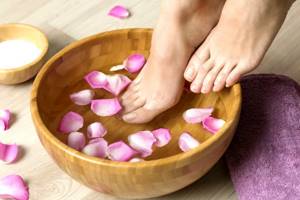
So the recipes look like this:
- Apply kombucha to the nail, treat with onion juice or spread with tar soap.
- Horseradish compress. Horseradish root needs to be crushed to a porridge state. You should steam your hands, trim your nails and apply a compress until the morning.
- Garlic compress. You will need to mix 2 g of salt, 1 liter of water and chopped garlic. Apply the resulting mixture to the affected areas.
Also in folk medicine there are methods such as:
- soak your feet in a solution with wine vinegar for 30 minutes;
- chop mint, add salt and apply the resulting porridge between your toes;
- mix vinegar (70%) and vegetable oil in equal proportions, lubricate the affected areas with the mixture.
The use of traditional medicine is dangerous and can only worsen the condition.
Recipes for healthy baths
You can use baths to prevent and treat nail deformation. And it’s quite easy to prepare them yourself:
- With salt (sea). To prepare, you will need 500 ml of water and 4 g of salt, which must be dissolved. Hands must be immersed in a bath with the resulting solution for 20 minutes. Then apply nourishing cream or oil.
- With iodine and table salt. To prepare, you will need 200 ml of water, 4 g of salt and 3 drops of iodine. All ingredients are mixed and nails are immersed in the prepared solution for 15 minutes.
- With honey, vegetable or olive oil, and lemon juice. Honey and oil are mixed in a water bath, followed by the addition of lemon juice. Some also add iodine and vitamin A. The resulting mixture is applied to the nails for half an hour.
Treatment at home
If nail deformation occurs due to deep grinding, interaction with chemicals, or injury, it is possible to correct the situation yourself.
If waves or roughness appear on the nail plate, then it is enough to sand it with a file and cover the surface with nourishing varnish. If it is due to exposure to household chemicals, then you should avoid direct contact with the skin of your hands and wait until a new one grows. Shallow sanding and the use of nourishing, restoring varnish or oil will also help at this time.
Special diet
When nail deformation occurs due to a lack of nutrients in the diet, then the doctor may prescribe special vitamin complexes and diet. It is based on foods rich in Ca, A, C, D, H, and B vitamins.
Special diet for deformed nails
The diet should contain:
- seafood;
- dairy products;
- non-fatty meats;
- porridge;
- fruits;
- vegetables;
- olive oil;
- nuts and dried fruits.
The diet is selected based on the individual characteristics of the patient’s body.
How are they formed?
Bo's transverse grooves on the nails are formed when the growth of the nail plate is temporarily disrupted. The living growing layer of the nail is found in the nail matrix, which is located under the cuticle. We see only a small zone of it - a white semicircle at the base of the nail, which is called the lunula or lunula.
When the supply of nutrients to the matrix decreases, the growth of the nail plate stops, and deformations in the form of characteristic depressions remain on the nail.
By the distance from the cuticle to the Beau-Reil line, you can determine when an injury or illness occurred that caused the deformation of the nail. The nail plate grows slowly, by 3–5 mm per month, so Beau’s lines do not appear immediately after exposure to a negative factor, but after 2–3 weeks. In order for the indentations to be clearly visible, the nail must grow. First, the dents appear on the lunula, and then move forward to the free edge.
The number, width, and depth of lines depend on the cause of disturbances in the matrix.
Masks for lumpy nails
The most effective against nail deformation are masks based on olive oil. But the following types of masks are also used:
- 4 g gelatin;
- 100 ml water;
- 2 g almond oil;
- 4 ml lemon oil.
Gelatin must be dissolved in water in a water bath, then add the remaining ingredients. The mass should harden, then it is ready to be applied to the nails for 20 minutes.
The second version of the mask includes rich baby cream and hot red pepper. The ingredients must be mixed 1:1 and applied to the required areas of the hands for no more than 10 minutes. The recipe has contraindications; if there are cuts or inflammations on the skin, then use is strictly prohibited.
Olive oil wrap
Hand care with olive oil is simple but very effective. It is enough to apply a mask, scrub, pure oil or make hand baths; repeat the procedure twice a week and the appearance of your nails will improve significantly. If you take pure olive oil, you should warm it up, apply it to your hands and put cotton gloves on top. It is better to carry out the procedure at night.
Olive oil wrap
But to prepare the mask you will need:
- 100 ml olive oil;
- 100 ml castor oil;
- 4 ml honey;
- 100 g chopped walnuts.
All ingredients are mixed and applied to hands for half an hour. Cotton gloves are put on over the top and the procedure is repeated twice a week.
Also equally effective is wrapping with olive oil and a few drops of iodine.
When to see a doctor?
If the injury is minor and the nail has slightly changed its color, then it is not necessary to contact a specialist. Over time, he will rehabilitate himself. If there is no unpleasant odor and the nail plate does not hurt, it is recommended to disinfect the nail plate every day.
If the injury is more serious, the nail turns blue, which is accompanied by pain and discomfort, then in this case you should contact a specialist immediately; the sooner the cause of the appearance of dark spots is determined, the more effective the treatment will be. A quick and correct diagnosis will help speed up recovery.
Prevention
By following measures to prevent nail deformation, you can significantly reduce the risk of its occurrence. To do this, it is enough to give up bad habits, having a thin nail plate, refuse the extension procedure, wear gloves when in contact with chemicals, and take care of the cuticle. It is worth adhering to a rational and proper diet with a high content of nutrients.
Prevention and treatment of deformed nails can be carried out independently, but it is recommended to consult a doctor first.
Thus, careful attitude towards one’s own health and timely response to clinical manifestations reduce the risk of developing any disease. Even deformation of fingernails, which is not so serious at first glance, can be a symptom of a dangerous disease.
Diagnostics
Regardless of the degree of damage to the natural manicure and the size of the resulting voids, it is not worth covering them with a decorative coating, since the problem can only progress because of this.
To begin eliminating onycholysis, it is recommended to first find out the cause of its formation. To do this, you need to go to the hospital to see a doctor - a surgeon, dermatologist or pathologist. If the reason for damage to the coating is a fungal infection, then you need to consult a mycologist.
Diagnosis of the disease begins with an examination of the affected area by a doctor, usually based on its visual condition, the diagnosis becomes clear.
However, to understand the depth of progression of the infection and the extent of its development in the epidermis, the surgeon can cut off the upper part of the pathology to examine the structure of the skin.
After this, the girl is prescribed restorative manipulations based on caring for the damaged area, which are aimed at healing the treated part. Also for this purpose, antimicrobial drugs and antibiotics are prescribed to prevent the development of the pathogen.
After the doctor determines the diagnosis of nail damage in a girl, she is prescribed a full treatment regimen.
